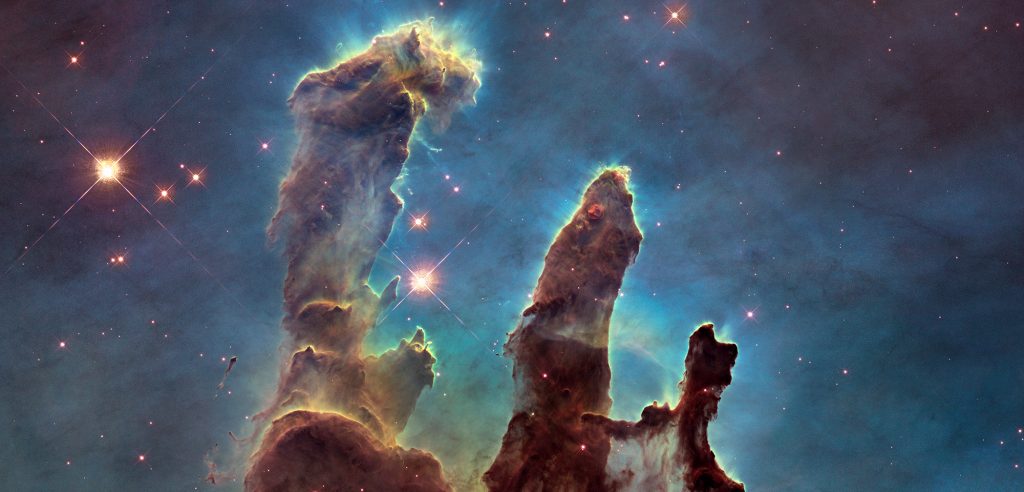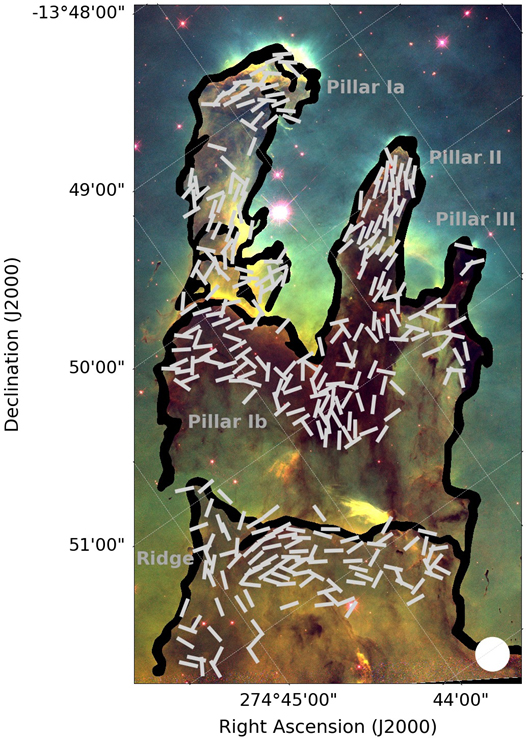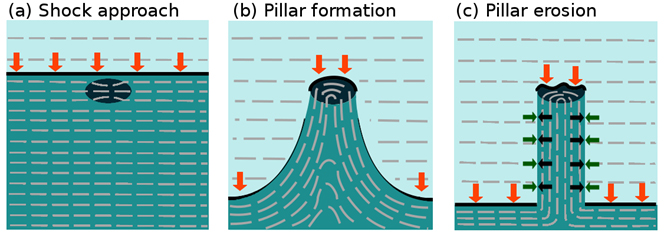Magnetic fields at the heart of the Pillars of Creation
An international team, known as the “BISTRO Consortium” (B-Fields in Star-Forming Region Observations) including Pierre Bastien, professor at the Université de Montréal and member of the Center for Research in Astrophysics of Quebec (CRAQ), has for the first time mapped the magnetic field within the dense gas of the “Pillars of Creation”. The observations were obtained using a high-resolution polarization imager installed on the James Clerk Maxwell submillimeter radio telescope (JCMT), which measures the vibration axis of electromagnetic waves.
The Pillars of Creation, estimated to be a little over a million years old, located in the heart of the Messier 16 star-formation region, also known as the Eagle Nebula, represents one of the most iconic images obtained by the Hubble Space Telescope (HST). The pillars are a set of cold and dense gas columns protruding into a region of hot ionized plasma. The pillars contain nurseries of new stars that form near the extremities, and are a particularly spectacular example of a feature found in many areas of the interstellar space where high-mass stars are formed.

The Pillars of Creation (Credits: HST)
These are the first high-resolution observations of the pillars obtained in polarized light at submillimeter wavelengths – submillimeter light being on the cusp between infrared and radio waves, where the cold, dense dust and the gas which will form the next generation of stars emits most of its light. Light emitted by these dusty regions is polarized perpendicular to the direction of its local magnetic field, and makes it possible to directly probe the magnetic field morphology within the dense gas of the Pillars of Creation. The observations were obtained at a wavelength of 0.85 mm as part of the BISTRO survey, using the POL-2 polarimeter, for which Pierre Bastien is the principal investigator, and the SCUBA-2 submillimeter camera of JCMT. They show that the magnetic field extends over the length of the pillars, at a significantly different angle from that of the field in the surrounding ionized plasma, and has an estimated strength of about 170 to 320 microGauss (1.7 to 3.2 × 10-8 Tesla), an intermediate magnetic field strength for a region of space where stars are formed. In comparison, the Earth’s magnetic field is about half a Gauss.

Orientation of the vectors of the magnetic field observed in the Pillars of the Creation, superimposed on an image of the nebula (Credits: BISTRO consortium and Hester et al.,1996, AJ 111, 2349).
Young hot stars, with masses more than eight times that of the Sun, produce large numbers of high-energy photons. These high-energy photons ionize a volume of the region within which they form, splitting hydrogen atoms into pairs of protons and elections. As the shock front between the material ionized by the young stars and the untouched neutral material advances, complex structures form in the dense gas at the interface. Particularly, pillars of dense, neutral gas like those in M16 are found protruding into the ionized region, apparently left behind by the advancing shock front. The formation and evolution of these pillars is not well-understood — debate continues as to whether these pillars form behind obstructions to the shock front, or whether they can form from turbulent instabilities in the shock front itself. The role of the magnetic field in the formation of the Pillars is particularly uncertain, since the strength of the magnetic field in the dense parts of the Pillars has not been measured until now.
Observations of the magnetic field running along the length of the Pillars are consistent with the Pillars being formed by compression of gas with an initially weak magnetic field: the magnetic field has not had the strength to resist being dragged into its current configuration by the motions of the gas. However, the magnetic field strength appears to have been increased by being compressed in the forming pillars. The magnetic field strength that we estimate is large enough to magnetically support the sides of Pillars against collapsing radially under pressure from the surrounding hot plasma, and to prevent the Pillars collapsing under their own gravity. It is important to note though that the Pillars are still being destroyed by the same shock interaction that created them: the magnetic field that we measure is not strong enough to prevent the Pillars being gradually eroded from their tips by the effects of the young stars in the region. The results suggest that the evolution and lifetime of the Pillars may thus be strongly influenced by the strength and orientation of their magnetic field: the Pillars’ longevity results from magnetic support.

The proposed evolutionary scenario: (a) an ionization front moving perpendicular to the ambient magnetic field approaches an existing over-density in the molecular gas. (b) The ionization front is slowed by the over-density. The flux-frozen magnetic field ‘bows’ into the forming pillar. (c) The compressed magnetic field supports the pillar against further gas-pressure- and gravity-driven radial collapse, but cannot support against longitudinal erosion of the over-density by ionizing photons. Throughout, dark blue shading represents molecular gas and light blue shading represents ionized material. The ionization front is shown as a black line. Grey dashed lines indicate the local magnetic field direction. Red arrows represent photon flux, black arrows represent magnetic pressure, and green arrows represent thermal gas pressure. (Credits: BISTRO consortium).
About the JCMT, POL-2 and BISTRO
The James Clerk Maxwell telescope, located on the Mauna Kea in Hawaii, is a radio telescope optimized for observations in the submillimeter domain of the electromagnetic spectrum. It is operated by the East Asian Observatory. The polarimeter POL-2 has a modulator which modifies the polarization by rotating at a speed of 2 Hz. This modulation makes it possible to compensate the variations of the atmosphere during the measurements. With a beam spanning 15 seconds of arc on the sky, this makes it an ideal instrument for studying the magnetic fields in the molecular gas filaments of the star formation regions in the solar neighborhood. The BISTRO Survey is a large team of scientists working to understand the role of magnetic fields in the formation of stars, with members from across the partner regions of the East Asian Observatory: China, Japan, South Korea, Taiwan and Vietnam, and from participating universities in the United Kingdom and Canada.
This research has been accepted for publication by The Astrophysical Journal Letters. A pre-print is available at http://arxiv.org/abs/1805.11554.
Contact:
Professeur Pierre Bastien
Centre de recherche en astrophysique du Québec
Université de Montréal
bastien@astro.umontreal.ca
Source :
Robert Lamontagne
Responsable des relations avec les médias
Centre de recherche en astrophysique du Québec
Téléphone : (438) 495-3482
lamont@astro.umontreal.ca
